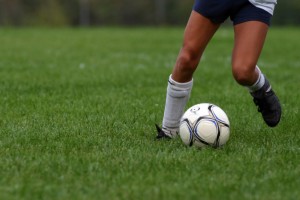Is your child active in sports like soccer or football that involve a lot of running? Does he/she complain of heel pain, especially in the mornings? Is he/she experiencing pain and swelling in their heel? Does he/she have trouble walking? Your child may have Sever disease.
What Causes Sever Disease?
Also called calcaneal apophysitis, Sever disease is a painful bone disorder that’s a common cause of heel pain in growing kids, especially those who are physically active. Typically Sever’s disease occurs when a child has a growth spurt during adolescence. During this growth spurt, the growth plate in your child’s heel grows faster than the muscles, tendons, and ligaments in their leg. When the muscles and tendons don’t grow fast enough to keep up with the growth plate, they become stretched too tight.
When your child is active in sports that involve a lot of running and jumping on hard surfaces, the overstretched tendons can become strained by the repetitive impact forces when the heel strikes the ground. This leads to pain and swelling in the area where the tendons attach to the growth plate in the heel.
What Ages Does Sever Disease Occur?
In girls, a growth spurt can occur between the ages of 8 and 13. In boys, it happens between 10 and 15 years old. Sever disease rarely occurs in teens over the age of 15 since the growth plates in your child’s heels have usually finished growing by this age. At that point, the growth plates harden and your child’s growing bones fuse together into mature bone.
How Is Sever Disease Treated?
 While Sever’s disease will resolve itself once the growth plate fuses, this can take several years. If your child is experiencing pain, it’s important to get it treated quickly.
While Sever’s disease will resolve itself once the growth plate fuses, this can take several years. If your child is experiencing pain, it’s important to get it treated quickly.
The first objective of treatment is to reduce inflammation and control your child’s pain. Typically, this is accomplished with ice to the heel, rest and anti-inflammatory medications.
Next, your child’s doctor will want to treat the biomechanical factors associated with Sever disease. This may involve:
- Increasing the contact area under your child’s foot to reduce high-pressure areas.
- Raising the heel to reduce tension on the Achilles tendon.
- Correcting any biomechanical misalignments like overpronation.
Typical Treatment Strategies
Two treatment strategies your doctor will likely recommend are:
- Stretching and strengthening exercises. These exercises are typically designed to increase the up-and-down range of motion in your child’s ankle, stretch out the muscles in the back of your child’s calf and reduce strain on the Achilles tendon.
- Orthotic devices. Orthotic devices help reduce stress on the growth plate and, if necessary, realign your child’s foot to correct for overpronation. Some common orthotic devices used are heel cups, heel wedges, and custom orthotics. Heel cups help compress the heel pad under the foot and maintain it in a central position. Heel wedges raise the position of the heel to relieve tension on the Achilles tendon. Custom orthotics can correct pronation while also relieving tension on the Achilles tendon.
With proper treatment, your child’s pain and inflammation can be reduced or eliminated within 3 to 6 weeks. So your child should be able to return to their normal activities.
Treat Sever Disease with WalkEZStore Custom Orthotics
If custom orthotics are recommended to treat your child’s Sever disease, contact Kathy Carandang, a certified pedorthist and founder of the WalkEZStore, for information on creating custom orthotics for your child. Custom orthotics created by the WalkEZStore can help your child’s feet function more efficiently while correcting skeletal misalignments. Our custom orthotics are ultra-thin and ¾ length, so they will fit a variety of children’s shoes. And they come with a 90-day, money-back guarantee.
Because … when your child’s feet feel good, they feel good.
Disclaimer: The information included in this article is for educational purposes only. It should not be used as a substitute for professional medical advice, diagnosis or treatment.


